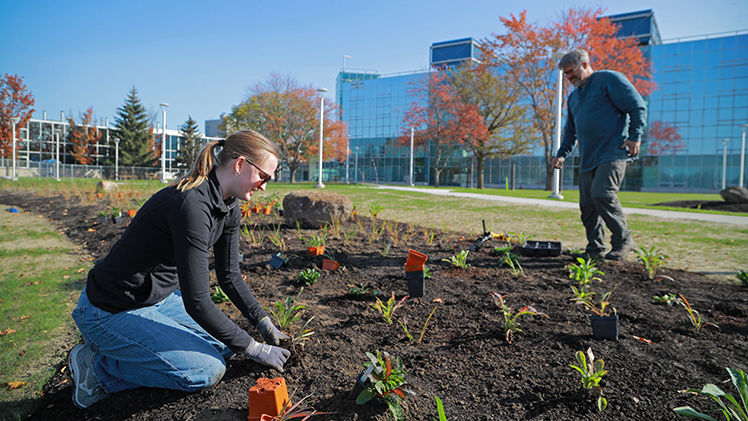Emma Heslop is used to instructing her peers in how to plant native species like dense blazing star, early goldenrod, little bluestem and rattlesnake master.
Her standard refrain? Don’t worry so much.

Emma Heslop, an environmental studies senior, and Dr. Todd Crail, a Distinguished University Lecturer in the Department of Environmental Sciences, plant native species in prepared beds on the new engineering quad in front of Nitschke Hall.
“It’s pretty common for the students we’re facilitating to start off very tentatively and to worry that they’re going to damage the plants or do something wrong,” the environmental studies senior said recently as she transferred dozens of seedlings into a prepared bed on the new engineering quad in front of Nitschke Hall. “We really stress that it’s hard to make mistakes. There’s not a lot that the native plants can’t bounce back from.”
Heslop is a student employee with Greening UToledo through Service Learning (GUTS), a student-facilitated service-learning initiative that aims to increase biodiversity on campus by establishing and maintaining native landscapes. Native plants are attractive as low-maintenance species with deep root systems that filter water runoff, sequester carbon and bring other environmental benefits to their ecosystems.
The engineering quad is one of two new gardens the program is planting this semester, bringing the total number of sites the student labor force maintains to nearly a dozen.
“Every one of these sites is classroom,” said Dr. Todd Crail, a Distinguished University Lecturer in the Department of Environmental Sciences who has overseen GUTS since its launch in 2016. “We have sites that are designed to mimic wetlands, woodlands, prairies — almost every type of ecosystem we see naturally in Lucas County. The students see the real-life applications of what they learn in their environmental sciences classes, while simultaneously combating climate change, improving the health of our watershed and supporting pollinators that depend on these plants for their survival.”
GUTS launched with support from the UToledo Student Green Fund, but today is financially sustainable thanks to a model that sees the University or its colleges contract the program to plant beds based on a square-foot calculation — an obvious choice for projects like the new engineering quad, which was celebrated with a ribbon-cutting in October.
“The opportunity to provide a hands-on service-learning experience for our students while beautifying our campus at a much lower cost than a commercial landscaper is very attractive,” said Jason Toth, senior associate vice president for administration. “We hope to continue to partner with GUTS going forward.”
This semester five student employees are coordinating opportunities for their peers to get their hands dirty in any of the beds the program inherited or has since established on Main Campus, as well seed storage and nursery facilities in and around Bowman-Oddy Laboratories. They also walk their peers through the processes of harvesting and storing seeds, germinating and transferring seedlings and tending to their native gardens.
More than 200 students put in an estimated 800 volunteer hours each year through GUTS.
Some of these students are like Grace Jimenez, an environmental sciences junior who connected with the program this semester to complete a service-learning requirement for her class Introduction to Environmental Studies.
Others — again like Jimenez, who showed up to the engineering quad to plant beside Heslop and Madison Dominguez, another student employee and environmental sciences junior — continue to volunteer well after their service-learning requirements are fulfilled.
“We were offered extra credit to put in extra hours,” Jimenez said. “But I enjoy the work, so a few classmates and I are just volunteering now.”
The engineering quad joins two beds at the north end of Glass Bowl Stadium as the newest additions to GUTS’ portfolio. Other sites include the courtyards of University Hall; several beds surrounding Bowman-Oddy Laboratories, Carlson Library and the Center for Performing Arts; and the Carolyn Edwards Memorial Rain Garden south of the Ottawa River.
As Heslop confidently tucked seedlings into the prepared beds on the engineering quad, she thought back to her own tentativeness in her early outings with GUTS.
“I couldn’t identify the plants or anything like that,” she said.
She’s learned a lot since then, she said, and not just about dense blazing star.
“I’m planning on going into environmental law,” Heslop said. “I’ve learned a lot from my environmental background and engaging with sustainability on a practical and not just theoretical level. That’s been one of the biggest things for me: GUTS bridges that gap between the classroom and what this actually looks like in the world.”